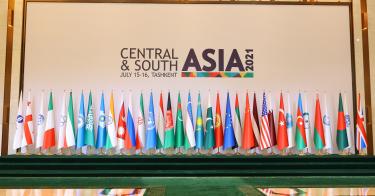The five-year old C5+1—forum that connects the five Central Asian nations, Kazakhstan, the Kyrgyz Republic, Tajikistan, Turkmenistan, and Uzbekistan, and the United States—has become a platform of growing importance for dialogues and cooperation. At a conference held in Tashkent, Uzbekistan, last week, the C5+1 nations took a positive step forward to expand economic freedom and regional connectivity.
At the C5+1 conference, entitled “Central and South Asia: Regional Connectivity. Challenges and Opportunities,” the countries adopted a joint statement that underscores their renewed commitment to work together and improve connections via trade, transportation, and energy links.
The United States’ primary strategic interest in this region, according to a U.S. strategy memo released in 2020, is:
to build a more stable and prosperous Central Asia that is free to pursue political, economic, and security interests with a variety of partners on its own terms; is connected to global markets and open to international investment; and has strong, democratic institutions, rule of law, and respect for human rights.
Indeed, Central Asia is a critical region that deserves America’s renewed attention. Many of the challenges that the U.S. now faces around the world, such as a resurgent Russia, an emboldened Iran, and the rise of Islamist extremism, have converged in Central Asia.
Not surprisingly, a resurgent China has attempted to make greater inroads in the region as part of its Belt and Road Initiative.
While recognizing this evolving geopolitical circumstance, Washington’s Central Asia strategy has pointed out that new leaders and governments in the region have created fresh openings for reform-oriented development and greater U.S. engagement. Now is the time to commit, as the strategy recommends, to pursuing “political and economic reform” in the region through “bilateral cooperation with the United States.”
Needless to say, the U.S. cannot give countries in the Central Asian region the political will that they need to transform their economies according to free-market principles. However, by becoming involved at critical levels of policy dialogue and implementation in the region, the U.S. can ensure that its guidance and concerns are taken into account.
To put it more bluntly, how far the C5+1 initiative can go will really depend on the continuous involvement and interest of the all parties involved, but particularly Washington.
One of the notable policy objectives that the Central Asia strategy identifies is to “promote United States investment in and [economic] development of Central Asia.”
To that end, the U.S. can engage at the practical level in a way that enables countries to advance their economic development. Fundamentally, America’s economic strength and competitive advantage in the region will be exercised best through the private-sector engagement that is the catalyst for real, meaningful economic transformation.
Although the United States and the five countries in the region signed a trade and investments framework agreement in 2004, the business environment of the region as a whole remains hampered by the severe economic freedom deficit caused by the weak rule of law, poor regulatory efficiency, and the lack of market openness—all of which has made the region unattractive to American investors.
It is notable that the reform minded Uzbekistan and Kazakhstan are two of the most improved nations over the past three years in The Heritage Foundation’s annual Index of Economic Freedom, but the region’s overall progress toward greater economic freedom has been uneven. The presence of state-owned enterprises in Central Asia as a whole remains considerable.
More than ever, it is in the interests of all the C5+1 countries to pursue greater economic freedom, including greater trade, more open investment environments, and improved connectivity to drive regional ties.
Realizing this strategic, mutually beneficial objective depends in no small part on America. We need to adhere to a coherent strategy for ensuring security and economic prosperity in the Central Asia region.
This piece originally appeared in The Daily Signal




